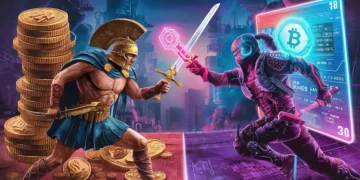Blast founder Tieshun Roquerre, aka Pacman, addressed what he described as some of the “misunderstandings” circulating on the platform, including claims from critics that Blast is being compared to a Ponzi scheme. He also said that following the receipt, investor Paradigm asked it to change its go-to-market strategy.
Blast went live on Tuesday in an early access, invite-only mode, following a $20 million raise from the likes of Paradigm and Standard Crypto. Blast claims to offer native Layer 2 yields for ether and stablecoins, with automatically compounded balances of 4 to 5%, in addition to invite rewards known as ‘Blast Points,’ the team said at launch. According to Dune Analytics, the project has attracted more than $400 million in bridge assets to date dashboard.
While admitting that the returns Blast offers users are “too good to be true,” Roquerre said Blast’s high returns come from legitimate platforms like Lido and MakerDAO. Lido’s revenue comes from Ethereum’s staking rewards, while MakerDAO’s revenue is derived from on-chain T-Bills, he said.
“These returns are not unsustainable. They are a core component of the on-chain and off-chain economy,” Roquerre continued. “The reason the return in Blast seems too good to be true is because Blast makes this return standard for everyone. “It gives users returns that were hidden in plain sight. In effect, higher returns are democratized.”
Furthermore, Roquerre addressed the comments surrounding Blast’s invite rewards. Far from being a marketing gimmick for growth’s sake, he emphasized that the system was a strategic move to promote community growth, recognizing the contribution users made by expanding the ecosystem – something that rewards deserved. Critics had likened Blast’s rewards structure to a pyramid scheme.
The founder also wanted to respond to memes about Paradigm being the real entity behind the project’s launch, stating that the crypto investment firm had “no involvement whatsoever” in Blast’s go-to-market strategy. “Honestly, they probably would have asked me to change a lot about the launch of Blast if they had been involved,” he said, adding that Blast had consulted Paradigm on research but not on its internal go-to-market plans .
He noted that Paradigm had asked him to make changes to plans after launch, which were pending, but said the Blast team would make the final decision.
Blast’s multisig security
In a separate one after Today, Blast also tried to clear the air on its multisig security, responding to criticism that it was controlled by just five people.
Blast said that, like other Layer 2 solutions such as Arbitrum, Optimism and Polygon, it uses a nuanced multisig security model to ensure the integrity of its platform, something the project said would be “very effective” if done right . Recognizing that security exists on a spectrum with different dimensions and attack vectors, Blast stated that while immutable smart contracts may appear more secure, they can still contain undetectable bugs despite audits. Upgradeable smart contracts also come with their risks, Blast added, especially with token-gated upgrades and time slots that can be exploited by malicious actors.
To address these challenges, Blast says it uses a multisig where each signature key is kept in cold storage, managed by geographically dispersed independent entities. The signatories are “highly technical engineers experienced in high-stakes apps ranging from financial applications to smart contracts,” it added.
To “improve security one step further,” Blast said it plans to diversify its hardware wallet suppliers to mitigate the risks of potential hardware compromises and ensure that “no type of hardware wallet is used three to five times.” ”
Disclaimer: Larry Cermak, CEO of The Block, is an angel investor in Blast.





















































































clomid risks can i get cheap clomiphene price how to buy cheap clomiphene without dr prescription where buy generic clomiphene tablets where buy clomiphene where to get generic clomid where buy clomiphene tablets
More posts like this would force the blogosphere more useful.
This is the tolerant of delivery I recoup helpful.
azithromycin 500mg price – buy generic flagyl 400mg metronidazole 200mg drug
buy motilium no prescription – buy domperidone 10mg for sale buy cyclobenzaprine cheap
buy propranolol generic – plavix 75mg cheap buy cheap methotrexate
augmentin 625mg pills – atbioinfo.com order
buy nexium – nexium to us buy esomeprazole 20mg generic
buy warfarin 2mg generic – blood thinner buy hyzaar cheap
buy meloxicam 15mg pills – https://moboxsin.com/ order mobic 15mg for sale
prednisone usa – asthma order deltasone online
cheapest ed pills online – https://fastedtotake.com/ non prescription erection pills
amoxicillin drug – cheap amoxicillin for sale purchase amoxicillin
purchase forcan for sale – buy fluconazole 200mg generic buy diflucan without prescription
cialis las vegas – fast ciltad cialis super active real online store
cialis coupon walmart – strong tadafl cialis com coupons
cheapest viagra buy cheap viagra – viagra sildenafil 100 mg order viagra usa
This is the kind of glad I enjoy reading. https://gnolvade.com/
I couldn’t weather commenting. Well written! prednisone online buy
More posts like this would add up to the online elbow-room more useful. https://ursxdol.com/cenforce-100-200-mg-ed/
This is a theme which is near to my fundamentals… Diverse thanks! Exactly where can I upon the phone details for questions? https://prohnrg.com/product/lisinopril-5-mg/
Greetings! Very productive recommendation within this article! It’s the little changes which will turn the largest changes. Thanks a lot in the direction of sharing! https://aranitidine.com/fr/acheter-fildena/
Greetings! Jolly gainful recommendation within this article! It’s the petty changes which choice obtain the largest changes. Thanks a quantity towards sharing! https://ondactone.com/spironolactone/